ELEVENTH INTERNATIONAL
ORGAN AND EARLY MUSIC FESTIVAL,
OAXACA, MEXICO
RESTORATION OF THE ORGAN
IN SAN MATÍAS JALATLACO
FEBRUARY 18 - 24, 2016

Each IOHIO Festival builds on the success of its predecessors, making this one the best ever! Nearly one hundred people from seven countries and six Mexican states participated in all or part of the scheduled activities. Of these, nearly a third were returnees and apparently couldn’t resist the opportunity to celebrate with us once again.
Twenty Oaxacan, Mexican, and foreign musicians collaborated in eight concerts on seven restored organs over the course of five days. Six Mexican organ students were offered scholarships to come to the festival, and our own nine local organists and students, three of whom played in collective concerts, were delighted to be their guides. Above all, hundreds of local people attended the concerts and heard the Oaxacan organs in all their glory.
In just a few days, we fulfilled all our stated goals:
• Promotion of the restored organs through the festival concerts
• Conservation of the unrestored organs through visits to organs in the regions of the Zapotec Central Valleys and the Mixteca Alta
• Musical and technical training through the participation of local organists in festival concerts and of a Oaxacan in the Jalatlaco restoration project
• Archive research through the exhibit of documents
• Organ Restoration through the work in process in San Matías Jalatlaco
February 18 (Thursday)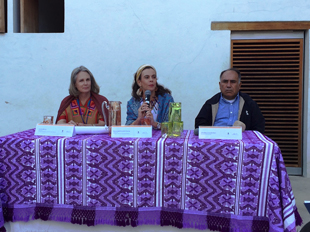
The Festival began with the Inauguration in the Oaxaca Philatelic Museum (MUFI). Cicely Winter, director of the IOHIO, spoke about the activities and goals of the festival. She was followed by María Isabel Grañen Porrúa, president of the Fundación Alfredo Harp Helú Oaxaca (FAHHO), and Padre Salvador Cruz Sánchez from Santa María Tlacolula, who offered congratulations from their respective institutions. Cicely expressed special appreciation to Alfredo Harp Helú for his indispensable support of seven organ restoration projects in Oaxaca over the past twenty years, as well as the restoration of the two monumental organs in the Mexico City Cathedral. There is no parallel anywhere in the world of a philanthropist who has demonstrated such a particular interest in the historic organs and none of the IOHIO activities since 2000, including the inauguration of this festival, would have been possible without Don Alfredo’s support.
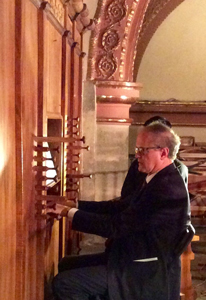
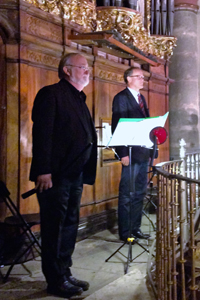
After a welcoming reception, everyone proceeded to the Oaxaca Cathedral for the First Concert of the Festival, offered by the renowned musicians Liuwe Tamminga (Netherlands), organ, and Bruce Dickey (program). Both are residents in Bologna and had been encouraged to participate in the festival by our mutual friend, Maestro Luigi Ferdinando Tagliavini. .A long line wound out into the atrium to purchase tickets (the only concert with an admission fee) and attendance surpassed 350 people. It was thrilling to hear the cornetto, an instrument popular in the renaissance which had fallen into disuse until its revival in recent decades, largely due to Bruce’s promotion and teaching. Its haunting sound intertwined with the organ to sound like one instrument, and Liuwe’s solos were brilliant.
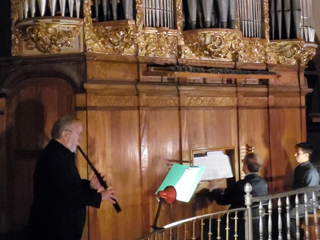
This and all succeeding concerts were projected onto a screen in the church so that the audience could have a better view of the artists and understand the relation of pulling the stops and the changing in the organ’s sound. This monumental 8´ instrument was built in 1712 and retains its opulently carved and gilded upper case, although its lower case has been rebuilt several times and unfortunately no evidence remains of its original appearance. However, we know from the contract for its construction that it was once one of the most lavishly decorated organs in Oaxaca.
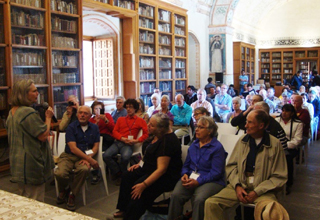
February 19 (Friday)
The day started with a bilingual presentation by Cicely Winter in the Francisco de Burgoa Library within the Santo Domingo Cultural Center about “The Historic Organs of Oaxaca and the Work of the IOHIO”. Although the title of the talk has not changed over the years, the content always does, and the images of the organs and the various IOHIO projects—protection, conservation, restoration, concerts, archive discoveries, recordings, and publications— spoke for themselves.
Our festivals are enriched by an exhibit of documents from local archives and this year the theme was “Pedro Nibra and Oaxacan Organbuilding in the mid-Nineteenth century” to highlight the restoration in process of the organ in San Matías Jalatlaco. María Isabel Grañen Porrúa, director of the Burgoa Library, is passionately interested in the preservation of historic documents and created the project ADABI (“Apoyo al Desarrollo de Archivos y Bibliotecas de México”) to refurbish archives and catalog documents. After she inaugurated the event, curator Ricardo Rodys described the material including payments to Nibra and records of later interventions in the Jalatlaco organ, as well as construction contracts for other Oaxacan organs.
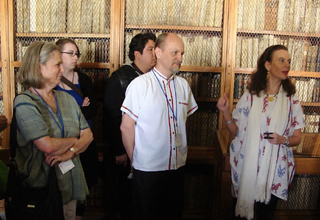 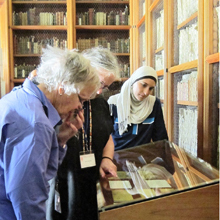
We proceeded to San Matías Jalatlaco located just on the edge of the historic center of Oaxaca City. We have always programmed a visit to this organ during our festivals and discussed our hopes for its restoration, but this time it was actually happening! This elegantly proportioned 8´ organ was built in 1866 by the Oaxacan organbuilder Pedro Nibra, then modified and painted its distinguishing blue color around 1880. First we all assembled in the parish conference room for a presentation by restorers Eric González and Alberto Compiani about the recently finished restoration of the organ case, Phase I of the project. We then divided the group in half which alternated between the choir loft to view the case up close and a temporary shop space to observe the windchest, keyboard, and pipes. Jalatlaco restoration
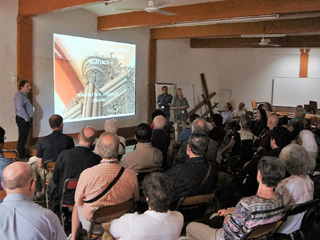 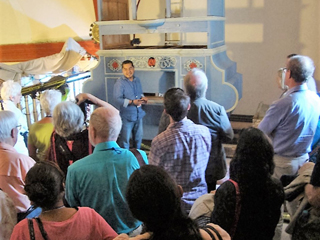
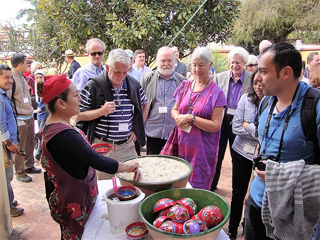
We continued on to San Andrés Huayapam located on the outskirts of Oaxaca City, where we were received with a drink of tejate, traditionally served in colorful painted half gourds. A local specialty of prehispanic origin, this delicious foamy drink is made with ground cacao, corn meal, the seed of the mamey fruit, and the flower of a tree (rosita de cacao) which grows only in and near Huayapam.
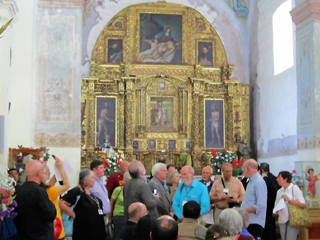
This charming church has one of the most beautiful altarpieces in Oaxaca, whose intricately carved columns are referred to as “gilded lace”. Also famous is the collection of antique exvotos, petitions usually to the Virgin Mary that are painted on small tin plaques. This and succeeding visits were enhanced by commentaries about the church art by restorer Alberto Compiani.
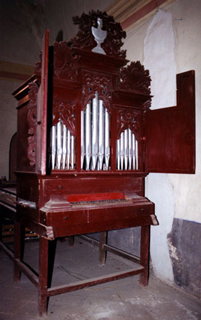
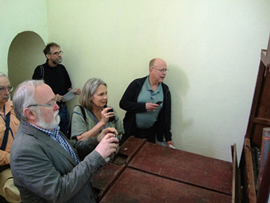
The 4´ organ (1772), large for a table organ, is nearly intact with its original keyboard and pipes. It is simply carved, a style we refer to as a “country organ”, and was once painted bright red, but overpainted a more sober maroon color in the 20th c.
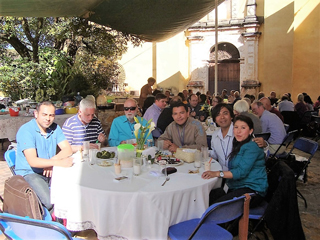
In Huayapam we savored the first of many local meals, this time mole amarillo, in the atrium of the church.
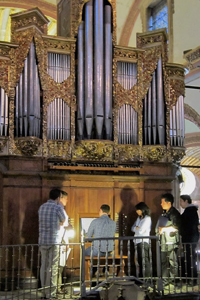
During the free time between the Huayapam comida and the evening concert, visiting organists had a chance to play in the Oaxaca Cathedral. This and succeeding opportunities to play the organs were organized by Joel Vasquez, our coordinator of musical activities and liaison with the churches.
Soon afterward, organist Cicely Winter and percussionist Valentín Hernández presented the Second Concert of the Festival, featuring well-known regional folk songs and dances (program). Originally programmed in the Basilica de la Soledad, which would have added an eighth organ to the roster, the concert was cancelled just days before the festival, creating a moment of panic, but fortunately it was rescheduled in the Cathedral. Such are the inevitable curveballs we face every year, and no matter how much we try to anticipate every eventuality in our planning, there are always surprises. The church was once again packed, people sang along lustily, and we consider this program a success only if the audience is screaming at the end!
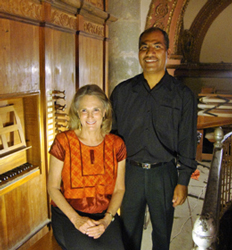 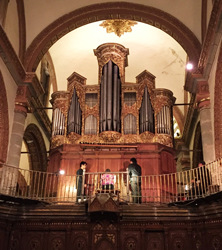
February 20 (Saturday)
Our excursion to the Mixteca Alta began with the Third Concert of the Festival in Santa María de la Natividad Tamazulapan and featured Oaxacan organists Tonatiuh González and Jesús González and three doctoral level organ students of Prof. Robert Bates (Houston), Jeffrey Cooper, Michael Ging, and Christopher Holman.
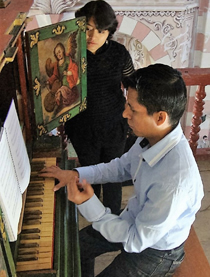 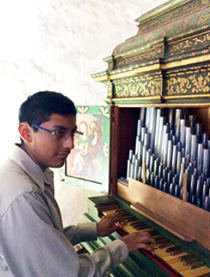 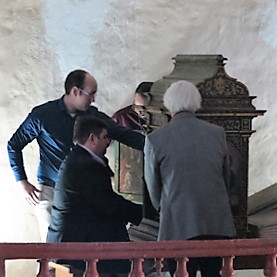
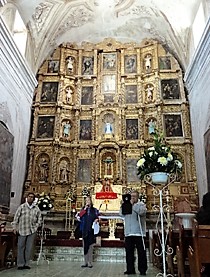
This was the first of three collective concerts, an experiment a few festivals back which has proved to be one of our most successful innovations. It gives foreign organists the chance to play and always guarantees a varied and interesting program. The 2´ table organ dating from approximately 1720-1730 is situated in a high balcony overlooking the huge nave of the church and is exquisitely decorated with images of saints and angel musicians. The case and bellows are original but the pipes, keyboard, and interior components were reconstructed in 1996. The church has one of the most magnificent baroque altarpieces in all Mexico and includes paintings by the renowned 16th century Spanish painter Andrés de Concha.
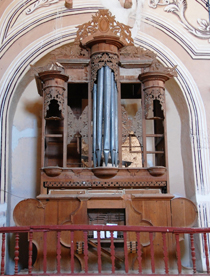
The second organ in this church, an imposing 8´ instrument, faces the small organ from the left balcony. Built in Oaxaca in 1840 by a member of the renowned Martinez Bonavides organbuilding family, it was once a magnificent instrument and is largely intact except that only the five largest façade pipes remain. The Tamazulapan church is one of only three in Oaxaca with two organs and the only one where two very different organs may be seen at the same time.
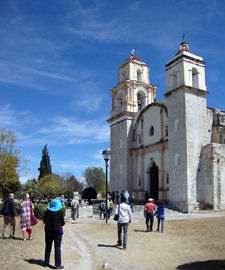
After the visit to Tamazulapan and before arriving in Yanhuitlán, both grandiose Dominican centers, we visited the church in Santiago Teotongo of more modest dimensions but equally rich in 18th c. baroque art. The magnificent case of this 8´ organ, though empty, stands as a work of art in its own right, and statues of angels once stood atop its towers, singing through their O-shaped mouths via a pipe which passed through each body. The organ was stripped of its pipes, keyboard, and more during the Mexican Revolution and its date is unknown, but the organ’s profile closely resembles that of San Mateo Yucucuí (1743).
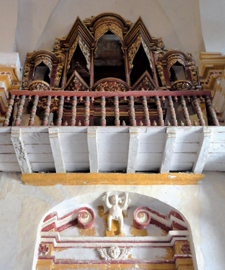 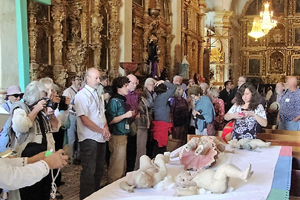
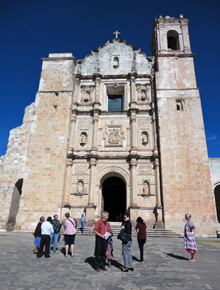
The Fourth Concert of the Festival took place in Santo Domingo Yanhuitlán, the 16th century Dominican stronghold in the Mixteca Alta region. With its soaring stone vault supported by lateral flying buttresses and its magnificent altarpieces, it is one of Mexico’s most majestic complexes of baroque art.
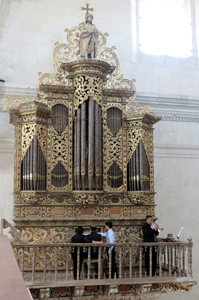
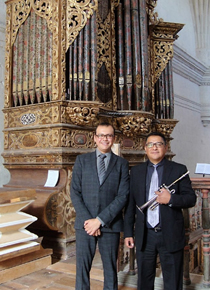
Organist Víctor Contreras and trumpeter Juan Luis González, both from near Mexico City, thrilled the audience with a program that reverberated throughout the immense nave. This magnificent organ, located on a side balcony, was built around 1690-1700 and restored in France in 1998. Its case is one of the most elaborately decorated in all of Mexico with fantastic swirling imagery and Dominican symbols painted on the case and fierce faces on the façade pipes.
We continued on to San Andrés Zautla and were received in the atrium of the church by the elderly women of the town, dressed in their traditional skirts and blouses, the local children’s band, fireworks, plenty of mezcal, necklaces of bugambilia, dancing and finally, a delicious meal of estofado de pollo (chicken stewed in almond sauce) served in the patio behind the church.
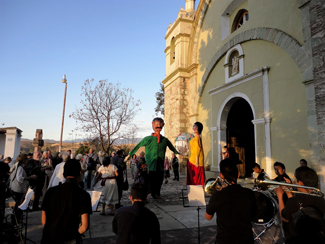 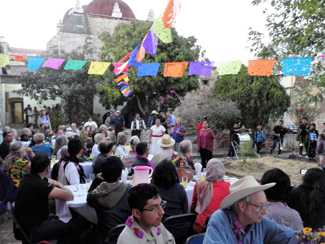
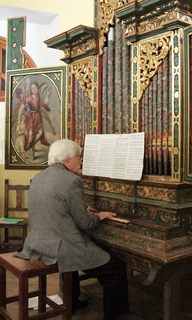
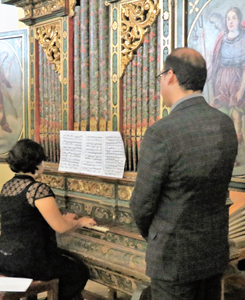
After dinner, we crowded into the lovely church where many local people were already waiting for the Fifth Concert of the Festival to begin. In this second collective concert, organists Margarita Ricárdez (Oaxaca), Víctor Contreras and Víctor Manuel Morales (Mexico City) and Robert Bates (USA) once again played wonderfully contrasting pieces, and there was a pleasant improvisatory tone to this presentation at the end of such a busy day. (program)
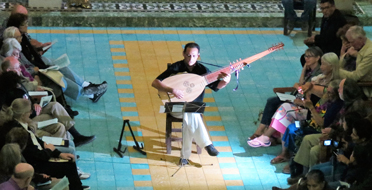
Alberto Revilla (Mexico City/Oaxaca) presented renaissance music for theorbo and flamenco guitar music in alternation with the organ, leaving the audience stunned by his artistry. The case of this 4´ table organ (1726) is exquisitely gilded and painted with images of saints and archangels.
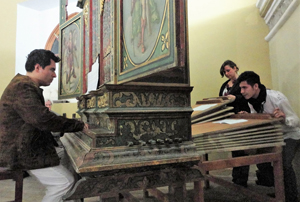
Like the organ in Tamazulapan, the bellows here are still hand pumped and the register sliders located on the sides of the case, so a concert may involve up to six people: the organist and page turner, someone on either side to control the registers and one or two people pumping the bellows. Thanks to the ongoing support of the Federal Road and Bridge Commission (CAPUFE), a special entrance was opened from the super highway, allowing us direct access back to Oaxaca.
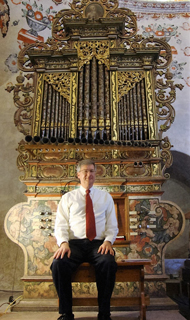
February 21 (Sunday)
American organist Craig Cramer presented the Sixth Concert of the Festival in San Jerónimo Tlacochahuaya. (program) Organbuilders Joaquín Lois and Hal Gober helped tune and condition the organ and it had never sounded so good. Craig’s precise touch coaxed deep, warm sounds from the organ and the audience was enthralled with his concert.
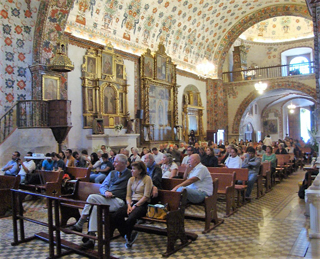
The church is one of the loveliest in Mexico with its exuberant interior floral decoration and gorgeous baroque altarpieces, all recently restored. The 4´ organ was built sometime before 1735 and restored in 1991. The case and pipes are decorated with floral motifs, and the organ harmonizes beautifully, both visually and acoustically, with the architecture of the church.
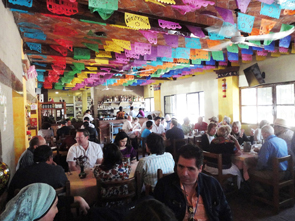
We savored a variety of Oaxacan specialties in the “Donají” Restaurant in Mitla, then proceeded to the nearby town of Santiago Matatlán.
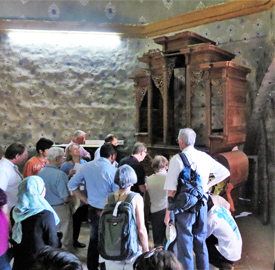
We always try to include a “new” organ in our tours and the Santiago Matatlan organ was irresistible because it is such an oddity: a large 4´ stationary organ with its windchest under the keyboard as in a smaller table organ, register pulls on the façade rather than on the sides, and a disproportionately large case with five towers, now empty, for a simple mechanism. The 18th c. church includes baroque altarpieces and its interior like many in Oaxaca was stenciled a vivid blue in the 19th c.
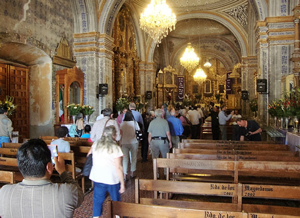 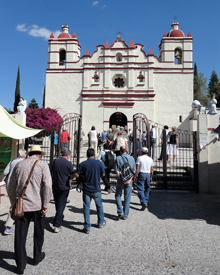
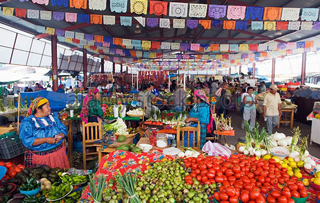
Our friends from “Chocolate Mayordomo” received us with bread and chocolate upon arrival in Santa María de la Asunción Tlacolula. Those who needed a break from churches could roam around one of the most famous indigenous markets in Oaxaca and admire the women’s costumes and the stalls piled high with local produce.
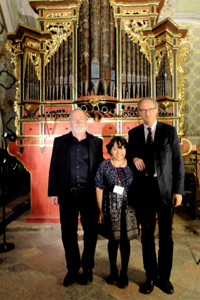 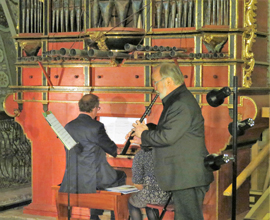
We were once again privileged to hear the rare and arresting combination of cornetto and organ in the Seventh Concert of the Festival presented by Liuwe Tamminga and Bruce Dickey. This time the cornetto accompanied an organ with a gentler and more vocal character than the more extroverted Cathedral instrument. (program)
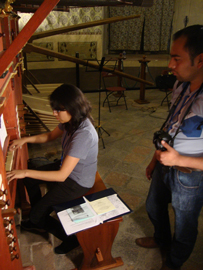
The 8´ organ was built in Oaxaca in 1792 by Manuel Neri y Carmona, restored by the Gerhard Grenzing Company and inaugurated during the Tenth IOHIO Festival in 2014. This organ also has the most elaborately painted façade pipes in all of Mexico, restored by Oaxacan Eric González.
After the concert, visiting organists scurried up to the choir loft to have a go at the organ before the mass and our departure for Oaxaca.
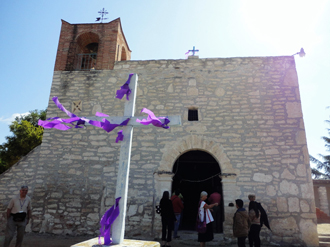
February 22 (Monday)
Our second all-day excursion to the Mixteca Alta was directed toward Tlaxiaco, three hours distant from Oaxaca City, with visits to organs along the way. Our first stop was at the little stone church in Santa María Tinú which houses a disproportionately large organ.
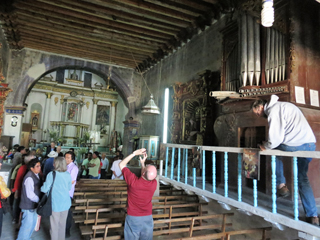
The date of construction 1828 and name of organbuilder are written inside the case….such luck! Perhaps the organ was originally commissioned for a larger church, then sold to Tinú, or the community simply wanted something grand. The organ, completely intact and played just a generation ago, still grunts and wheezes when one of the bellows located in the loft above is pumped. Some organs inspire affection and this is definitely one of them…. Unfortunately there are only 136 people left in the town so a restoration would not be practical. It should be noted that Mexican law protecting the national heritage prohibits the removal of sacred art objects from their churches of origin.
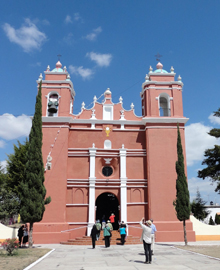 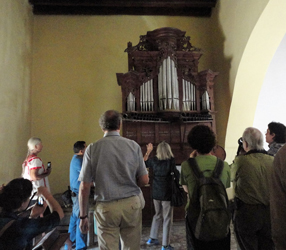
Some years had passed since we last included a visit to San Andrés Sinaxtla in our festival tour, so it was of particular interest to many regular participants to see it for the first time. This instrument is neo-classic in design, with a richly carved unpainted case. Of particular interest is the inscription across the façade including the name of the donor, the date of construction 1791, and the cost, but typically omitting the name of the organbuilder. It presents an interesting contrast to the Tlacolula organ, built in the same year in baroque style, the late 18th c representing the transition from the baroque to the neo-classic aesthetic.
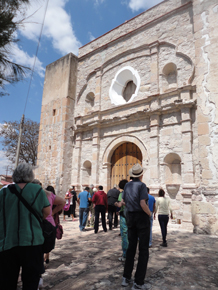
Just down the road from Sinaxtla sitting on a promontory overlooking the Yanhuitlán Valley is the church of San Mateo Yucucuí (population 130). This organ built in 1743 is the least altered of all the 8´ 18th c. Oaxacan organs and when last played (1930s?), it is said that its sound could be heard for miles around. The organ was never painted or gilded like its counterpart in Teotongo, probably not by choice during that opulent baroque era, but rather because of the cost. It is richly carved and largely intact and one only wishes that the pipes and mechanism of the Yucucuí organ could be inserted into the stunning Teotongo case to make one amazing organ! The floor of the high balcony on which the organ sits is much deteriorated and access to the façade is dangerous, so our efforts to clean and document the organ have been restricted.
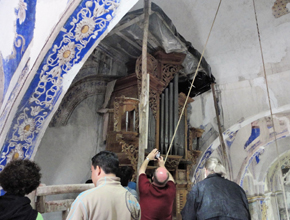 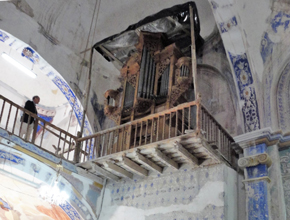
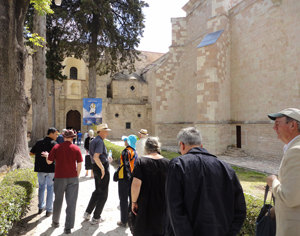
Our next stop was at the Dominican architectural complex of San Pedro y San Pablo Teposcolula with its famous 16th c. open chapel and 18th c. church. The 8´ organ (ca. 1730-1740) has a similar profile to that of Yanhuitlán. Its original finish was natural wood, then it was later painted white with green touches, a lovely look. Now we refer to it as the King Midas organ, because in 2010 a well-connected architect took the liberty of gilding at great cost all the decorative carvings and moldings, even though it had only been minimally gilded historically and in fact the organ’s overall manufacture is not of the highest quality. Our main conservation challenges over the years have been related to negligence of the organs (accumulated filth, vandalism, the intrusion of animals) or the consequences of natural disasters or construction projects. We never imagined that the whimsical decisions of misguided “experts” would pose an equal risk.
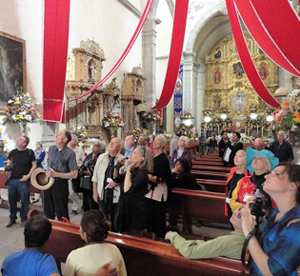 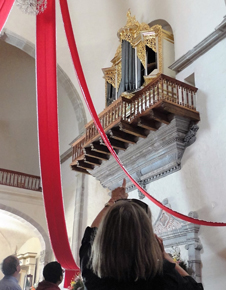

After lunch in Teposcolula, we drove up through the pine fores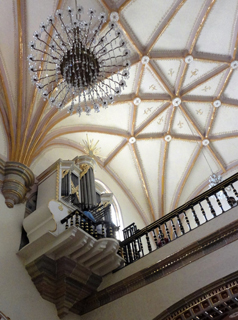 t to Santa María Tlaxiaco. For the final Eighth Concert of the Festival. Liuwe Tamminga, David Furniss, Marilou Kratzenstein, Craig Cramer, and William Autry offered an eclectic program with some American and French pieces added to the more standard Spanish and Italian repertoire. t to Santa María Tlaxiaco. For the final Eighth Concert of the Festival. Liuwe Tamminga, David Furniss, Marilou Kratzenstein, Craig Cramer, and William Autry offered an eclectic program with some American and French pieces added to the more standard Spanish and Italian repertoire.
This monumental 8´ instrument, built around 1800 and restored in 2000, is the “youngest” of all the restored Oaxacan instruments. The imposing, outwardly austere church was the Dominican outpost for this strategic area of the high sierra in the 16th century. All the altarpieces in the church and the organ are synchronized in neo-classic design and painted white, gold and red, creating a pleasing visual coherence, although we know that there was a baroque predecessor organ and altarpieces in the 17th century. We spent the night in the Hotel del Portal right on the main plaza.
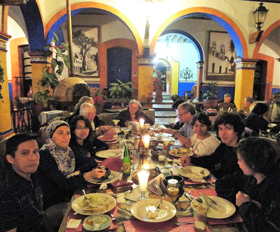
February 23 (Tuesday)
After a luscious buffet breakfast, participants divided into two groups. Many, including most of the students, opted to stay in town to play the Tlaxiaco organ and had great fun trying out their pieces, laughing, commenting, and helping each other with the registers.
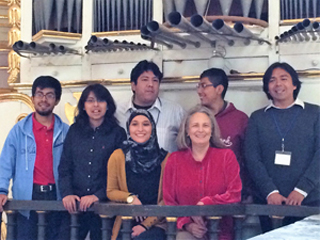
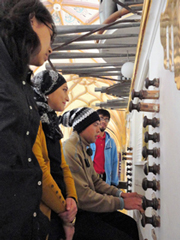
The others decided to visit the late pre-classic and classic (400 BC – 800 AD) Mixtec archeological site and the community museum of San Martín Huamelulpan with Marcus Winter of the INAH.
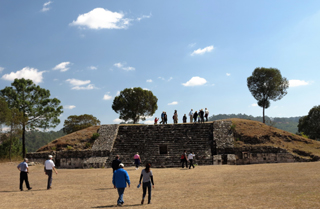 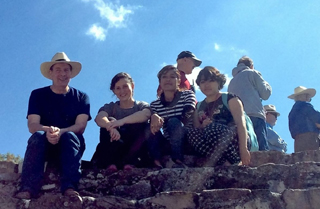
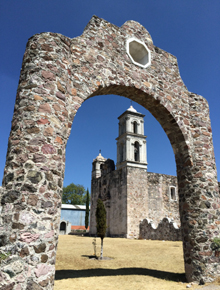
Both groups met up in the village of San Pedro Mártir Yucuxaco. The organ here (1740) is complete and in excellent condition, missing only its bellows. It is the least altered of the Oaxacan 4´ table organs, parallel to Yucucui for the 8´ stationary group and closely resembles the organ in Zautla, though without the painted decoration. The carved pipeshades include two faces in profile, a unique decorative detail, and the keyboard is exquisite.
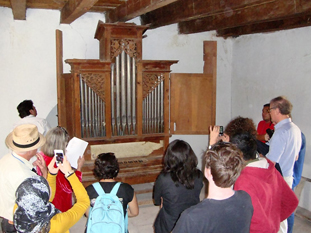 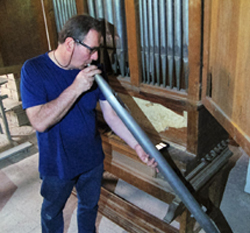
Our Mixtec tour continued with a visit to the church and organ of Santiago Tejupan. The luxuriously painted organ case (1776) is the last in Oaxaca with religious imagery. Portraits of the donor and his wife being blessed by his patron saint are depicted on one side and Santiago on horseback on the other, both unfortunately obscured by layers of grime. Another special feature is the information painted on two decorative medallions on the façade which include the name of the donor, the cost of the organ, and the date of construction, although as in Sinaxtla, omitting the name of the organ builder. Here we find yet another church which could stand as a museum of colonial religious art in this culturally rich area of the Mixteca Alta.
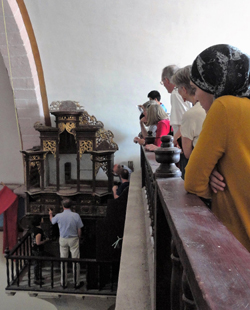
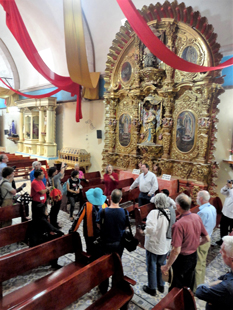
Our final church and organ visit was in Santa María Tiltepec, for some the crowning visual experience of the field trips. Located in the Dominican sphere of Yanhuitlan and built atop a prehispanic temple, this 16th century church has long been appreciated by art historians for its richly carved asymmetrical façade and stone interior arches. The unrestored 4´ organ, situated on a side balcony, is one of Oaxaca’s oldest (1703) and often elicits a gasp of astonishment when seen for the first time. Unfortunately nothing is known about its history to explain its idiosyncrasies of construction and decoration and if it didn’t have hips, we might wonder if it were imported.
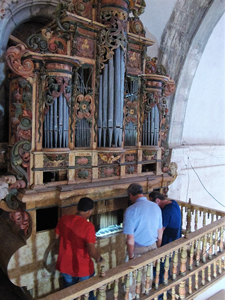
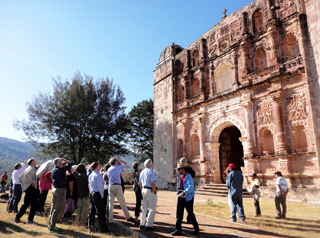
We then walked down the hill and across the river to the home of the Cruz García family for our farewell dinner. We feasted on barbacoa de borrego, lamb barbecued Oaxacan style, cooked in the ground over hot rocks and covered with maguey leaves. Mezcal from San Bartolo Yautepec flowed freely, and everyone had one last chance to celebrate with old and new friends before returning to Oaxaca.
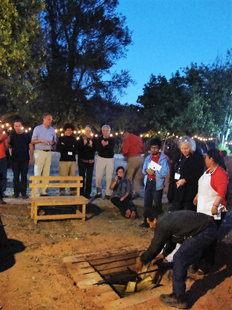
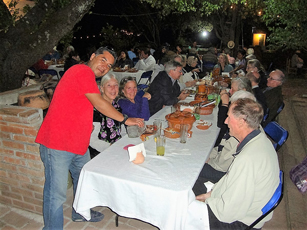
February 24 (Wednesday)
Even after the closing event in Tiltepec, this Festival just would not stop and the following day 25 people made the trek up to the archeological site of Monte Albán with Dr. Marcus Winter (INAH).
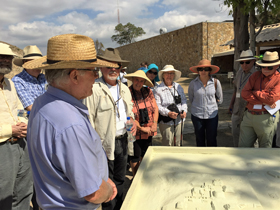 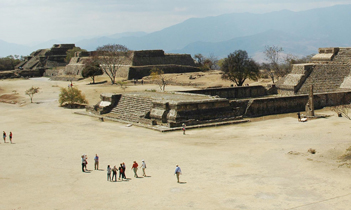
Conclusion
High spirits and a sense of camaraderie prevailed, new friendships, professional collaborations, and even a romance (!) were forged, and this time the festival group began to feel more than ever like a family. Several participants have mentioned that our festivals have been life-changing experiences, and we know what they mean. The organs have opened up undreamed of opportunities for us in the IOHIO as well, and led us to new places, new people, and new insights. We have never forgotten the thrill of hearing the first chord of a restored organ in concert or climbing up a winding stone staircase to the choir loft and confronting an organ for the first time. These large, heavy instruments are rooted in their churches and were once, and in some cases are now, vital parts of the musical life and surrounding culture of their communities. Each organ has a story to tell and we try to listen carefully, because ultimately it is these stories which structure our festivals and make them so unique.
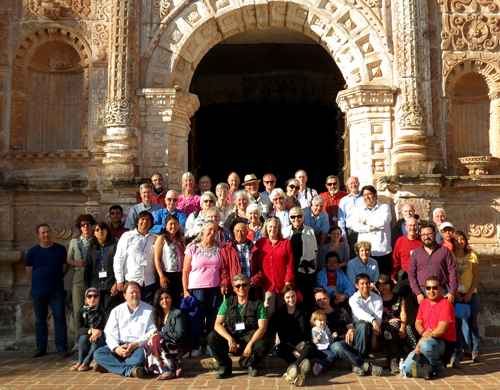
The IOHIO is grateful for the support of the following institutions:
Secretaria de Cultura INAH
Arquidiócesis de Antequera Oaxaca
Biblioteca Francisco de Burgoa
Museo de Filatelia de Oaxaca (MUFI)
Caminos y Puentes Federales (CAPUFE)
We are also grateful for the support of the following Oaxacan businesses:
Hostal de la Noría
Hotel Parador San Agustín
Hotel de la Parra
Hotel Gala
Color Digital
Chocolate Mayordomo
|

